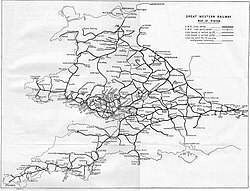Related Research Articles

The 4073 or Castle Class are 4-6-0 steam locomotives of the Great Western Railway, built between 1923 and 1950. They were designed by the railway's Chief Mechanical Engineer, Charles Collett, for working the company's express passenger trains. They could reach speeds of up to 100 mph (160 km/h).

George Jackson Churchward was an English railway engineer, and was chief mechanical engineer of the Great Western Railway (GWR) in the United Kingdom from 1902 to 1922.
The Great Western Railway 3800 Class, also known as the County Class, were a class of 4-4-0 steam locomotives for express passenger train work introduced in 1904 in a batch of ten. Two more batches followed in 1906 and 1912 with minor differences. They were designed by George Jackson Churchward, who used standard components to produce a four-coupled version of his Saint Class 4-6-0s.

The Great Western Railway 2900 Class or Saint Class, which was built by the Great Western Railway's Swindon Works, incorporated several series of 2-cylinder passenger steam locomotives designed by George Jackson Churchward and built between 1902 and 1913 with differences in the dimensions. The majority of these were built as 4-6-0 locomotives; but thirteen examples were built as 4-4-2. They proved to be a highly successful class which established the design principles for GWR 2-cylinder classes over the next fifty years, and influenced similar classes on other British railways.
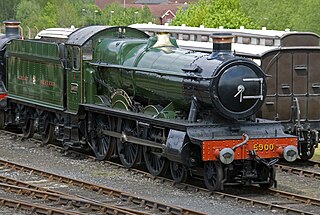
The Great Western Railway 4900 Class or Hall Class is a class of 4-6-0 mixed-traffic steam locomotives designed by Charles Collett for the Great Western Railway. A total of 259 were built at Swindon Works, numbered 4900–4999, 5900–5999 and 6900–6958. The LMS Stanier Class 5 4-6-0 and LNER Thompson Class B1 both drew heavily on design features of the Hall Class. After nationalisation in 1948, British Railways gave them the power classification 5MT.

The Great Western Railway (GWR) 6800 Class or Grange Class was a mixed-traffic class of 4-6-0 steam locomotive, built to replace the GWR 4300 Class 2-6-0. There were 80 in the class, all built at the Swindon works, using some reconditioned parts from withdrawn 4300 Class locomotives.

The Great Western Railway (GWR) 6959 or Modified Hall Class is a class of 4-6-0 steam locomotive. They were a development by Frederick Hawksworth of Charles Collett's earlier Hall Class named after English and Welsh country houses.
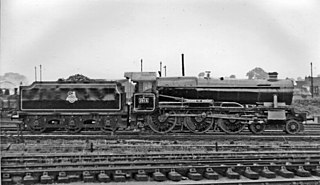
The Great Western Railway 1000 Class or County Class was a class of 4-6-0 steam locomotive. Thirty examples were built between 1945 and 1947, but all were withdrawn and scrapped in the early 1960s. A replica locomotive is under construction.
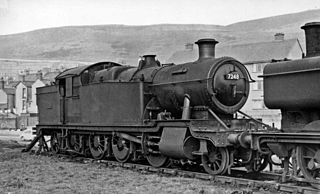
The Great Western Railway (GWR) 7200 Class is a class of 2-8-2T steam locomotive. They were the only 2-8-2Ts built and used by a British railway, and the largest tank engines to run on the Great Western Railway.

The Great Western Railway (GWR) 4300 Class is a class of 2-6-0 (mogul) steam locomotives, designed by G.J. Churchward for mixed traffic duties. 342 were built from 1911–1932.

The Great Western Railway (GWR) 2221 Class or County Tank was a class of 4-4-2T steam locomotive, effectively a tank engine version of the 3800 "County" Class 4-4-0 tender locomotives. The two classes had different boilers, standard no 4 for the tender locomotive, and the smaller standard no 2 for the tank. 2230 was fitted with the larger boiler when new, but this was unsuccessful and was quickly altered.
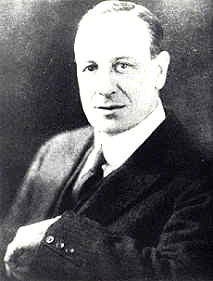
Charles Benjamin Collett was Chief Mechanical Engineer of the Great Western Railway from 1922 to 1941. He designed the GWR's 4-6-0 Castle and King Class express passenger locomotives.

Frederick William Hawksworth, was the last Chief Mechanical Engineer of the Great Western Railway (GWR).
The Great Western Railway (GWR) 3100 Class was a class of 2-6-2T side tank steam locomotive.

The Great Western Railway (GWR) 4700 Class was a class of nine 2-8-0 steam locomotives, designed by George Jackson Churchward. They were introduced in 1919 for heavy mixed-traffic work. Although primarily designed for fast freight, the class also sometimes hauled passenger trains, notably heavy holiday expresses in the summer months. They were unofficially nicknamed "Night Owls" because they were primarily designed to haul goods during the night and they could be seen simmering in the daylight, awaiting their nocturnal duties.
The GWR was the longest-lived of the pre-nationalisation railway companies in Britain, surviving the 'Grouping' of the railways in 1923 almost unchanged. As a result, the history of its numbering and classification of locomotives is relatively complicated. This page explains the principal systems that were used.

GWR 6800 Class No. 6880 Betton Grangeis a steam locomotive built between 1998 and 2024 as a "new-build" project, originally based on the Llangollen Railway in Denbighshire, Wales, then subsequently at Tyseley Locomotive Works. Described as "building the 81st Grange", the project started in 1998, and the locomotive was earlier expected to be operational by 2013, but subsequently by Autumn 2021, which was then pushed back to 2024. It was expected to be launched under steam in a private member event in January 2024 but was postponed a week before the event. On 11 April 2024, 6880 was steamed up for the first time after more than 25 years of work. All of the original GWR 6800 Class Grange locomotives were withdrawn for scrap by the end of 1965; this project is a creation, from an assemblage of original GWR and newly manufactured components, of a member of this class.

The GWR 101 Class consisted of a single experimental 0-4-0T side-tank steam locomotive. It was built at GWR Swindon Works under the direction of George Jackson Churchward in June 1902.

The Great Western Railway (GWR) 3901 Class is a class of 2-6-2T steam locomotives rebuilt from class 2301 'Dean Goods' 0-6-0 tender locomotives.
The Great Western Railway (GWR) experimented with oil burning steam locomotives at two points in its history. A single experimental tank engine was constructed to burn oil in 1902, and 37 engines of four different classes were converted to burn oil between 1946 and 1950. Neither experiment resulted in the long-term use of oil as fuel for steam locomotives. A single pannier tank locomotive was also converted under British Rail in 1958.
References
- Gibson, John C. (1984). Great Western locomotive design : a critical appreciation. Newton Abbot [Devon]: David & Charles. ISBN 0-7153-8606-9.
- "Drawing of 4400 class". The Great Western Archive. Retrieved 2 January 2021.
- Griffiths, Denis (1987). Locomotive engineers of the GWR. Wellingborough: Stephens. ISBN 0-85059-819-2.
- G.W.R. engines: names, numbers, types & classes. Newton Abbot: David and Charles. 1971. ISBN 0-7153-5367-5.
- Haresnape, Brian (1976). Churchward locomotives : a pictorial history. London: I. Allan. ISBN 0-7110-0697-0.
- Haresnape, Brian (1978). Collett & Hawksworth locomotives : a pictorial history. London: I. Allan. ISBN 0-7110-0869-8.
- Holcroft, Harold (1957). An Outline of Great Western Railway Locomotive Practice. London: Locomotive Publishing Co Ltd.
- "Great Western Railway inspired 2-6-0 9351 class No. 9351". West Somerset Railway. Retrieved 4 January 2021.
- Whitehurst, Brian (1973). Great Western engines, names, numbers, types, classes: 1940 to preservation. Oxford: Oxford Pub. Co. ISBN 0-902888-21-8.
